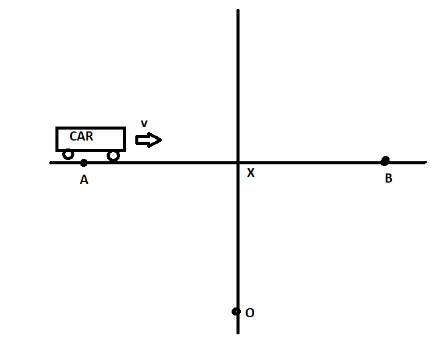
A car giving horn is moving towards a crossing as shown in figure. At the instant when the observer O hears the same frequency as the frequency as the horn, the car will be
A. Between A and X
B. Between X and B
C. At X
D. Before A


Answer
547.8k+ views
Hint:In the above question, we have to note the change in the sound of car horn moving with a constant velocity. The phenomena which observe the change in the wave frequency is known as doppler effect. Doppler effect is produced by moving source (car) in which there is upward shift when source is approaching towards the observer and downward shift when source is receding from the observer.
Complete answer:
Doppler effect is defined as the change in the frequency of wave during relative motion between a source and its observer.
${f_o} = \dfrac{{v + {v_o}}}{{v + {v_s}}}{f_s}$
Where ${f_o}$ is the observer frequency, $v$ is the speed of sound waves, ${v_o}$ is observer velocity, ${v_s}$ is the source velocity and ${f_s}$ is the frequency of source.
In our above question, we want to know the position of the car where it will observe the same frequency. To solve this let us calculate frequency at every point given in question
Between A and X: in this path the car is observing the point O, hence by doppler shift will observe upward shift.
Between X and B: in this path the car is receding the point O and will observe downward shift.
At X: It will observe the same frequency as at O which is the required answer.
The correct option is C.
Note:If the source is still and the observer is moving will give the same result as when the source is moving and the observer is still. Just keep in mind that when the source is approaching the observer there will be an upward shift and when the source is receding the observer there will be a downward shift.
Complete answer:
Doppler effect is defined as the change in the frequency of wave during relative motion between a source and its observer.
${f_o} = \dfrac{{v + {v_o}}}{{v + {v_s}}}{f_s}$
Where ${f_o}$ is the observer frequency, $v$ is the speed of sound waves, ${v_o}$ is observer velocity, ${v_s}$ is the source velocity and ${f_s}$ is the frequency of source.
In our above question, we want to know the position of the car where it will observe the same frequency. To solve this let us calculate frequency at every point given in question
Between A and X: in this path the car is observing the point O, hence by doppler shift will observe upward shift.
Between X and B: in this path the car is receding the point O and will observe downward shift.
At X: It will observe the same frequency as at O which is the required answer.
The correct option is C.
Note:If the source is still and the observer is moving will give the same result as when the source is moving and the observer is still. Just keep in mind that when the source is approaching the observer there will be an upward shift and when the source is receding the observer there will be a downward shift.
Recently Updated Pages
Why are manures considered better than fertilizers class 11 biology CBSE

Find the coordinates of the midpoint of the line segment class 11 maths CBSE

Distinguish between static friction limiting friction class 11 physics CBSE

The Chairman of the constituent Assembly was A Jawaharlal class 11 social science CBSE

The first National Commission on Labour NCL submitted class 11 social science CBSE

Number of all subshell of n + l 7 is A 4 B 5 C 6 D class 11 chemistry CBSE

Trending doubts
Differentiate between an exothermic and an endothermic class 11 chemistry CBSE

10 examples of friction in our daily life

One Metric ton is equal to kg A 10000 B 1000 C 100 class 11 physics CBSE

Difference Between Prokaryotic Cells and Eukaryotic Cells

1 Quintal is equal to a 110 kg b 10 kg c 100kg d 1000 class 11 physics CBSE

State the laws of reflection of light




